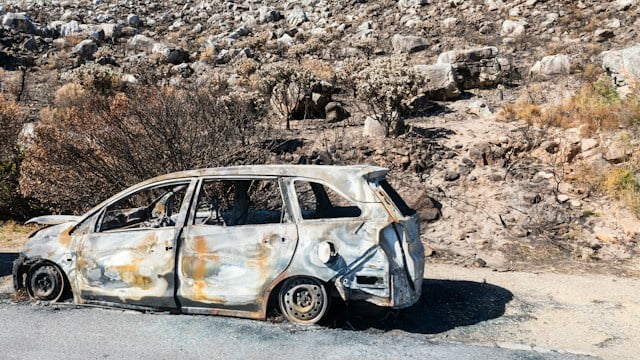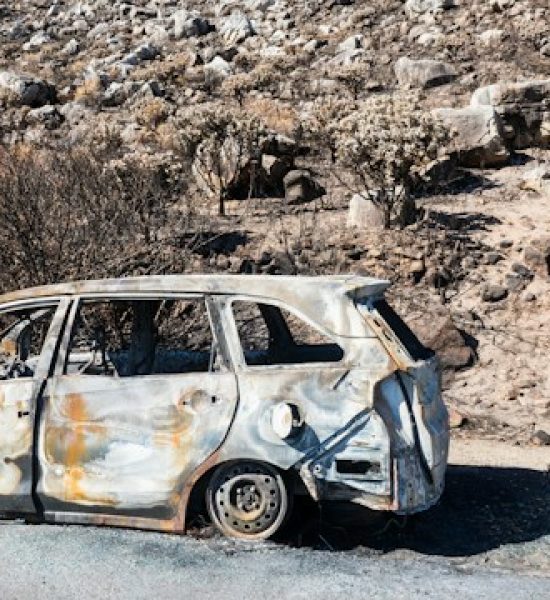Comprehensive physical damage coverage, often referred to as just “comprehensive coverage,” is an optional component of auto insurance that protects a variety of non-collision incidents. While coverage may vary between insurance policies and providers, comprehensive insurance typically covers damage to your vehicle caused by events other than collisions. Here are common perils covered by comprehensive physical damage insurance:

- Weather-related incidents: This includes damage caused by natural disasters such as hailstorms, hurricanes, tornadoes, floods, and earthquakes.
Comprehensive physical damage coverage typically includes protection against various weather-related incidents. Here are some examples of weather-related events that are commonly covered by comprehensive insurance:
- Hail damage: Comprehensive coverage can help pay for repairs or the replacement of your vehicle if it is damaged by hail.
- Windstorm damage: If your car sustains damage due to strong winds, such as fallen tree branches or debris, comprehensive coverage should cover the costs.
- Flood damage: Comprehensive insurance often provides protection against damage caused by flooding. It’s important to note that standard comprehensive coverage usually covers freshwater flooding, but additional coverage may be required for saltwater flooding (commonly associated with hurricanes or tidal surges).
- Tornado damage: If your vehicle is damaged in a tornado, comprehensive coverage should help cover the repair or replacement costs.
- Hurricane damage: Comprehensive insurance typically covers damage caused by hurricanes, including wind, rain, and flooding. However, as mentioned earlier, saltwater flooding may require additional coverage.
It’s crucial to carefully review your insurance policy and discuss any specific concerns or questions with your insurance provider. Additionally, coverage details can vary, so be sure to understand the terms, conditions, and limits of your comprehensive coverage as it relates to weather-related incidents.
- Theft: If your vehicle is stolen, comprehensive coverage can help cover the cost of replacing the stolen vehicle.
Comprehensive physical damage coverage also includes protection against theft of your vehicle. If your car is stolen, comprehensive insurance will help cover the cost of replacing your stolen vehicle, subject to the terms and conditions outlined in your policy.
Here are some key points related to theft coverage under comprehensive insurance:
- Stolen vehicle: If your car is stolen and not recovered, your comprehensive coverage will typically provide compensation for the value of the stolen vehicle, up to the policy’s limits.
- Personal belongings: While comprehensive coverage primarily focuses on the vehicle itself, personal belongings inside the stolen car may also be covered up to a certain limit. However, coverage for personal items might be limited compared to coverage for the vehicle.
- Exclusions: Insurance policies may have specific conditions or exclusions related to theft coverage. For example, leaving your keys in the ignition or the vehicle running unattended might impact your ability to make a theft claim.
- Deductible: As with other aspects of comprehensive coverage, there is usually a deductible associated with theft claims. The deductible is the amount you are responsible for paying out of pocket before the insurance coverage kicks in.
It’s important to review your insurance policy and understand the terms and conditions of the theft coverage. If you live in an area with a higher risk of vehicle theft, comprehensive coverage can provide valuable protection. Additionally, taking preventive measures such as using anti-theft devices may not only enhance your vehicle’s security but could also potentially lower your insurance premiums. Always consult with your insurance provider to clarify any questions or concerns related to theft coverage.
- Vandalism: Damage resulting from intentional acts of vandalism, such as keying or spray-painting your car.
Comprehensive physical damage coverage typically includes protection against vandalism. If your vehicle is intentionally damaged by acts of vandalism, such as graffiti, keying, or other malicious acts, comprehensive insurance can help cover the cost of repairing or replacing your damaged vehicle.
Here are some key points related to vandalism coverage under comprehensive insurance:
- Intentional damage: Comprehensive coverage is designed to protect against non-collision events, and vandalism is considered one of these covered events. This includes any intentional damage caused by others to your vehicle.
- Coverage limits: The amount of coverage for vandalism will be subject to the limits specified in your insurance policy. It’s essential to review your policy to understand the maximum amount the insurance company will pay for vandalism-related damages.
- Deductible: Like other aspects of comprehensive coverage, vandalism claims usually come with a deductible. You will need to pay the deductible before the insurance coverage takes effect.
- Prompt reporting: If your vehicle has been vandalized, it’s crucial to report the incident to the police and your insurance company promptly. Insurance companies typically require a police report for vandalism claims.
- Exclusions: Always check for any specific conditions or exclusions in your policy related to vandalism. For instance, some policies may have limitations on coverage if the vehicle was left in an unsecured location.
Understanding the details of your comprehensive coverage and discussing any questions with your insurance provider is essential. Vandalism can happen in various situations, so having comprehensive coverage can provide peace of mind by protecting your vehicle against intentional damage caused by others.
- Fire: Coverage for damage caused by fires, whether they are accidental or intentional.
Comprehensive physical damage coverage typically includes protection against damage caused by fires. If your vehicle is damaged or destroyed due to a fire, comprehensive insurance can help cover the cost of repairing or replacing your damaged vehicle, subject to the terms and conditions outlined in your policy.
Here are some key points related to fire coverage under comprehensive insurance:
- Coverage for fire damage: Comprehensive coverage generally extends to damage caused by fires, whether accidental or intentional. This can include damage to the vehicle’s structure, interior, and other components.
- Exclusions: It’s important to review your insurance policy to understand any specific conditions or exclusions related to fire coverage. For example, if the fire resulted from illegal activities or if the vehicle was not in compliance with safety regulations, coverage may be affected.
- Deductible: Like other aspects of comprehensive coverage, fire claims usually come with a deductible. You will need to pay the deductible amount before your insurance coverage takes effect.
- Prompt reporting: In the event of a fire damaging your vehicle, it’s crucial to report the incident to your insurance company as soon as possible. Insurance companies often require prompt reporting to process claims efficiently.
- Additional living expenses: In some cases, comprehensive coverage may include coverage for additional living expenses if you are temporarily displaced from your home due to a fire involving your vehicle. This can help with costs such as temporary accommodations.
As always, carefully review your insurance policy and discuss any questions or concerns with your insurance provider to ensure you have a clear understanding of the terms, conditions, and limits of your coverage for fire-related incidents.
- Falling objects: Protection against damage caused by falling objects, such as tree branches or debris.
Comprehensive physical damage coverage typically includes protection against damage caused by falling objects. If your vehicle is damaged due to objects falling onto it, such as tree branches, debris, or other items, comprehensive insurance can help cover the cost of repairing or replacing your damaged vehicle.
Here are some key points related to coverage for damage caused by falling objects under comprehensive insurance:
- Coverage for falling objects: Comprehensive coverage is designed to protect against non-collision events, and damage from falling objects is generally included in this coverage. This can include damage to the vehicle’s body, windows, roof, or other components.
- Examples of falling objects: Common examples of falling objects that may be covered include tree branches, rocks, hailstones, or other debris. The coverage extends to various scenarios, including those caused by natural events like storms or accidents.
- Exclusions: It’s important to review your insurance policy to understand any specific conditions or exclusions related to falling objects. For example, if the falling object was intentionally caused by someone or if the vehicle was in an area where it shouldn’t have been parked, coverage may be affected.
- Deductible: As with other aspects of comprehensive coverage, claims for damage caused by falling objects usually come with a deductible. You will need to pay the deductible amount before your insurance coverage takes effect.
- Prompt reporting: In the event of damage caused by a falling object, it’s important to report the incident to your insurance company promptly. Timely reporting helps streamline the claims process.
Always check the details of your insurance policy, discuss any questions with your insurance provider, and ensure you have a clear understanding of the terms, conditions, and limits of your coverage for damage caused by falling objects.
- Animal collisions: Coverage for damage caused by hitting an animal, such as a deer or a bird.
Comprehensive physical damage coverage typically includes protection against damage caused by collisions with animals. If your vehicle is involved in an accident with an animal, such as a deer, a dog, or another wildlife creature, comprehensive insurance can help cover the cost of repairing or replacing your damaged vehicle.
Here are some key points related to coverage for animal collisions under comprehensive insurance:
- Coverage for animal collisions: Comprehensive coverage is designed to protect against non-collision events, and accidents involving animals are generally included in this coverage. This coverage extends to damage caused by collisions with a wide range of animals.
- Examples of animal collisions: Common examples include collisions with deer, dogs, cats, or other wildlife. These incidents can happen on roads, especially in areas where there is a higher prevalence of wildlife.
- Exclusions: Review your insurance policy to understand any specific conditions or exclusions related to animal collisions. Some policies may have limitations, such as coverage for domestic animals but not for wild animals, or exclusions based on certain circumstances.
- Deductible: As with other aspects of comprehensive coverage, claims for damage caused by animal collisions usually come with a deductible. You will need to pay the deductible amount before your insurance coverage takes effect.
- Prompt reporting: If your vehicle is involved in a collision with an animal, it’s important to report the incident to your insurance company promptly. Timely reporting helps facilitate the claims process.
Animal collisions can cause significant damage to a vehicle, so having comprehensive coverage is valuable in protecting against such incidents. Always check the details of your insurance policy, discuss any questions with your insurance provider, and ensure you have a clear understanding of the terms, conditions, and limits of your coverage for collisions with animals.
- Civil disturbances: Coverage for damage caused by civil disturbances, riots, or other acts of civil unrest.
Comprehensive physical damage coverage may provide protection against damage to your vehicle resulting from civil disturbances or riots. If your car is damaged due to events such as protests, riots, or other civil disturbances, comprehensive insurance can help cover the cost of repairing or replacing your damaged vehicle.
Here are some key points related to coverage for damage caused by civil disturbances under comprehensive insurance:
- Coverage for civil disturbances: Comprehensive coverage is designed to protect against non-collision events, and damage caused by civil disturbances is generally included in this coverage. This can include damage to your vehicle due to vandalism, looting, or other acts of civil unrest.
- Exclusions: Review your insurance policy to understand any specific conditions or exclusions related to damage caused by civil disturbances. Some policies may have limitations based on the level of involvement in the disturbance or may exclude coverage for certain types of damage.
- Deductible: As with other aspects of comprehensive coverage, claims for damage caused by civil disturbances usually come with a deductible. You will need to pay the deductible amount before your insurance coverage takes effect.
- Prompt reporting: If your vehicle is damaged during a civil disturbance, it’s important to report the incident to your insurance company promptly. Timely reporting helps facilitate the claims process.
- Police reports: Insurance companies often require a police report as part of the claims process for damage resulting from civil disturbances. Make sure to cooperate with law enforcement and obtain the necessary documentation.
As civil disturbances can lead to unexpected damage to vehicles, having comprehensive coverage provides a layer of protection against these events. Always check the details of your insurance policy, discuss any questions with your insurance provider, and ensure you have a clear understanding of the terms, conditions, and limits of your coverage for damage caused by civil disturbances.
It’s important to note that comprehensive coverage usually comes with a deductible, which is the amount you must pay out of pocket before the insurance coverage kicks in. The higher the deductible, the lower your insurance premium is likely to be.
Comprehensive coverage is often optional, and whether you choose to include it in your auto insurance policy depends on factors such as the value of your vehicle, your budget, and your geographical location (considering the prevalence of certain risks like natural disasters or high rates of theft). Always review your insurance policy and consult with your insurance provider to understand the specific terms, conditions, and limits of your comprehensive coverage.




